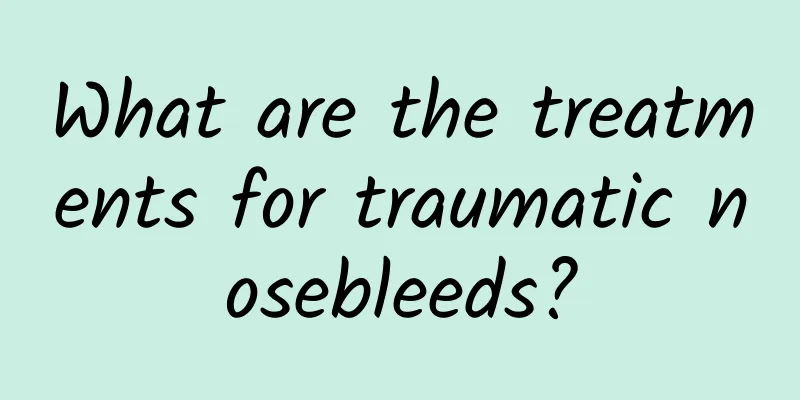What are the treatments for traumatic nosebleeds?

|
Traumatic nosebleed is caused by external reasons. Once traumatic nosebleed occurs, we must treat it in time, because traumatic nosebleed may cause some complications. Traumatic nosebleed can cause respiratory obstruction and shock in patients. So what methods do we have to deal with traumatic nosebleed? There are many treatments for traumatic nosebleeds. We must choose the method that suits us. The treatment of traumatic nosebleeds requires dealing with aspects such as airway obstruction and shock. 1. Treatment of airway obstruction For nosebleeds caused by trauma, attention should be paid to the respiratory tract condition and appropriate treatment should be given according to severity and urgency. For those with respiratory obstruction, that should be relieved first. 2. Treatment of shock For patients with severe bleeding, it is not advisable to examine them calmly. In addition to taking immediate measures to stop the bleeding, it is also necessary to quickly determine whether there is hemorrhagic shock. After shock occurs, nose bleeding often stops on its own and should not be mistaken for recovery. Attention should be paid to the early symptoms of shock, such as weak and clotted pulse, anxiety, irritability, pale complexion, thirst, cold sweat, chest tightness, etc. If the amount of bleeding reaches 500-1000ml, you should pay attention to keeping warm, take the side-lying position, give oxygen, and immediately give intravenous infusion. When the systolic blood pressure is lower than 11.3kPa (85mmHg), it means that a large amount of blood volume has been lost and blood transfusion should be given in time. Red blood cell count and hemoglobin measurement have no reference value for estimating the amount of acute epistaxis. 3. Application of hemostatic drugs Hemostatic drugs only play an auxiliary role in traumatic epistaxis. Anluoxue and Zhixuemin are effective for capillary bleeding, 6-aminocaproic acid is generally effective for people with coagulation dysfunction, and vitamin K is effective for people with reduced prothrombin. 4. Local hemostasis method (1) Local drug hemostasis; (2) Local cautery and coagulation method; (3) Blockage hemostasis method: ① anterior nasal blockage method; ② posterior nasal blockage method; ③ artery ligation method. Above we introduced what traumatic nosebleed is. We know that traumatic nosebleed is caused by external factors that cause nose bleeding. Traumatic nosebleed is prone to complications, so we must treat it in time. Above we introduced the treatment method of traumatic nosebleed, I believe everyone has mastered it. |
<<: What are the treatments for traumatic nosebleeds?
>>: Interpreting the causes of dermatomyositis from the perspective of traditional Chinese medicine
Recommend
How to treat sweat herpes on hands
When people are nervous or the weather is hot, th...
Why do I feel weak?
If you feel weak at ordinary times, it may be rel...
How to relieve cesarean section uterine contraction pain
After a cesarean section, the mother will often e...
Can I eat angelica during menopause?
After women enter menopause, their tempers will b...
Reasons for excessive sweating
Excessive sweating is quite common in daily life....
What does the vaginal discharge look like when your period is coming?
The appearance of leucorrhea can be used to deter...
Is pulmonary edema life-threatening? Recognize its seriousness in time
Pulmonary effusion is very troublesome to patient...
White sticky discharge during ovulation
Women are more concerned about health issues duri...
How to treat hypoxic-ischemic encephalopathy in infants
The occurrence of hypoxic-ischemic encephalopathy...
How to adjust the bite of teeth
If the teeth are not aligned, it will often affec...
The difference between Chinese medicine and Western medicine
Once a disease occurs in the human body, timely t...
What causes platelet drop?
Before lung cancer patients undergo chemotherapy,...
What to do if a meat ball grows inside a tooth cavity
A tooth cavity is a type of tooth decay or tooth ...
What causes breast pain after menstruation?
Breast pain is relatively common among women. Pre...
What are the differences between Lu Codonopsis and Codonopsis?
As we all know, we can't be careless with med...









